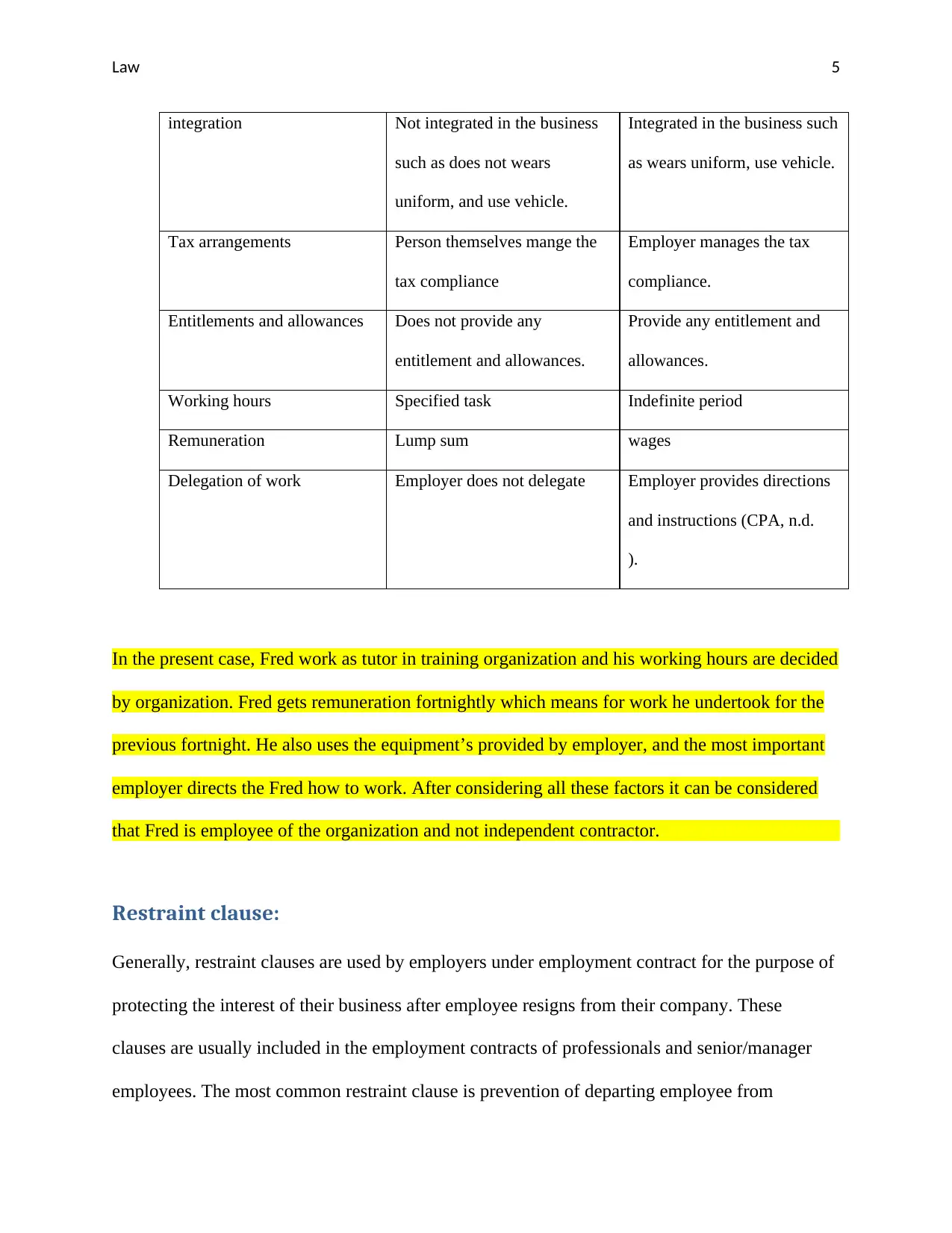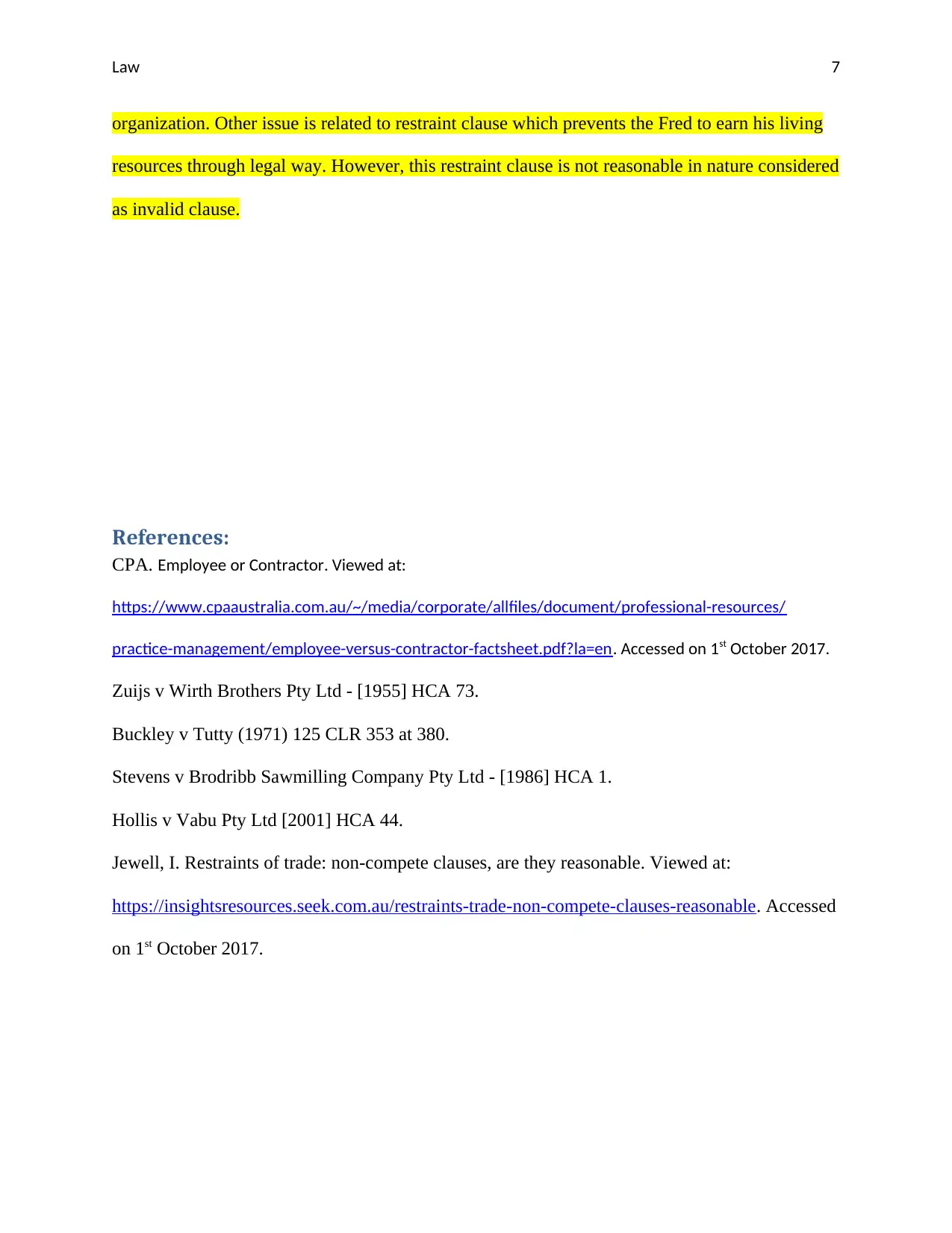Law Report: Employee vs. Independent Contractor Analysis
VerifiedAdded on 2019/10/31
|7
|1133
|312
Report
AI Summary
This report delves into the critical distinctions between employees and independent contractors, exploring the legal ramifications of each status. It examines key differences, such as the nature of contracts (service vs. for services) and the level of control exerted by the employer. The report outlines various tests, including the control test, integration test, and the multiple indicia test, used to determine an individual's employment status. Furthermore, it addresses the concept of restraint clauses, common in employment contracts, and analyzes their validity based on reasonableness and public welfare considerations. The report references relevant case law and concludes with a clear determination of Fred's employment status and the validity of the restraint clause in his contract.

Running Head: Law 1
Law
Law
Paraphrase This Document
Need a fresh take? Get an instant paraphrase of this document with our AI Paraphraser

Law 2

Law 3
Abstract:
This report states the difference between employee and independent contractor, and also states
various tests through which status of person as employee or independent contractor is
determined. In this restrains clause and whether these clauses are valid is also discussed. After
considering the facts of this report it is clear that at the time of formation of contracts all the
rights and liabilities of person in course of employment must be clearly stated.
Introduction:
Generally, employers take shield of contracts by stating that person is appointed as independent
contractor and has no rights as employees under employment law. This report states, issues
related to contracts which states that that person is considered as employment law. It also states,
issues related to current restraint clause. Subsequently, this paper is concluded with brief
conclusion.
Issues related to status of employee or independent contractor:
The fundamental differences between the employee and independent contractor are stated below:
Employee enters into contract of service and independent contract for services.
Control is accessed by employer over the employee, but in case of independent contractor
employer does not access any control over independent contractor.
In case of employee, employer is vicariously liable for the acts of employees.
Abstract:
This report states the difference between employee and independent contractor, and also states
various tests through which status of person as employee or independent contractor is
determined. In this restrains clause and whether these clauses are valid is also discussed. After
considering the facts of this report it is clear that at the time of formation of contracts all the
rights and liabilities of person in course of employment must be clearly stated.
Introduction:
Generally, employers take shield of contracts by stating that person is appointed as independent
contractor and has no rights as employees under employment law. This report states, issues
related to contracts which states that that person is considered as employment law. It also states,
issues related to current restraint clause. Subsequently, this paper is concluded with brief
conclusion.
Issues related to status of employee or independent contractor:
The fundamental differences between the employee and independent contractor are stated below:
Employee enters into contract of service and independent contract for services.
Control is accessed by employer over the employee, but in case of independent contractor
employer does not access any control over independent contractor.
In case of employee, employer is vicariously liable for the acts of employees.
⊘ This is a preview!⊘
Do you want full access?
Subscribe today to unlock all pages.

Trusted by 1+ million students worldwide

Law 4
In other words, independent contractor performs an agreed task for an agreed price and employer
does not control the working hours of the employee and how such work is carried on by
independent contractor.
Generally, employer considered person as independent contractor for the purpose of avoiding
federal and state legal requirements. However, if characteristics of employment of person are
resemble from employee then such person is considered as employee and not independent
contractor. Numbers of tests are determined by common law for the purpose of determining the
status of person as employee or independent contractor and these tests are stated below:
In case Zuijs v Wirth Bros, Court determine the control test and state that if employer
access control over the person then such person is considered as employee, and control is
determined through significant relationship shared by them.
Other test is integration test which determine the degree of integration worker accessed in
the employment such whether worker wears uniform provided by employer or not.
The most important and last test is multiple indicia test, and this test was introduced in
case Stevens v Broadribb Sawmilling Co Pty Ltd, and this test was later confirmed in
Hollis v Vabu Pty Limited in Australia. This test consider all the essential circumstances
of the employment for the purpose of determining the status:
FACTOR INDEPENDENT
CONTRACTOR
EMPLOYEE
Equipment and tools If not supplied by employer If supplied by employer.
In other words, independent contractor performs an agreed task for an agreed price and employer
does not control the working hours of the employee and how such work is carried on by
independent contractor.
Generally, employer considered person as independent contractor for the purpose of avoiding
federal and state legal requirements. However, if characteristics of employment of person are
resemble from employee then such person is considered as employee and not independent
contractor. Numbers of tests are determined by common law for the purpose of determining the
status of person as employee or independent contractor and these tests are stated below:
In case Zuijs v Wirth Bros, Court determine the control test and state that if employer
access control over the person then such person is considered as employee, and control is
determined through significant relationship shared by them.
Other test is integration test which determine the degree of integration worker accessed in
the employment such whether worker wears uniform provided by employer or not.
The most important and last test is multiple indicia test, and this test was introduced in
case Stevens v Broadribb Sawmilling Co Pty Ltd, and this test was later confirmed in
Hollis v Vabu Pty Limited in Australia. This test consider all the essential circumstances
of the employment for the purpose of determining the status:
FACTOR INDEPENDENT
CONTRACTOR
EMPLOYEE
Equipment and tools If not supplied by employer If supplied by employer.
Paraphrase This Document
Need a fresh take? Get an instant paraphrase of this document with our AI Paraphraser

Law 5
integration Not integrated in the business
such as does not wears
uniform, and use vehicle.
Integrated in the business such
as wears uniform, use vehicle.
Tax arrangements Person themselves mange the
tax compliance
Employer manages the tax
compliance.
Entitlements and allowances Does not provide any
entitlement and allowances.
Provide any entitlement and
allowances.
Working hours Specified task Indefinite period
Remuneration Lump sum wages
Delegation of work Employer does not delegate Employer provides directions
and instructions (CPA, n.d.
).
In the present case, Fred work as tutor in training organization and his working hours are decided
by organization. Fred gets remuneration fortnightly which means for work he undertook for the
previous fortnight. He also uses the equipment’s provided by employer, and the most important
employer directs the Fred how to work. After considering all these factors it can be considered
that Fred is employee of the organization and not independent contractor.
Restraint clause:
Generally, restraint clauses are used by employers under employment contract for the purpose of
protecting the interest of their business after employee resigns from their company. These
clauses are usually included in the employment contracts of professionals and senior/manager
employees. The most common restraint clause is prevention of departing employee from
integration Not integrated in the business
such as does not wears
uniform, and use vehicle.
Integrated in the business such
as wears uniform, use vehicle.
Tax arrangements Person themselves mange the
tax compliance
Employer manages the tax
compliance.
Entitlements and allowances Does not provide any
entitlement and allowances.
Provide any entitlement and
allowances.
Working hours Specified task Indefinite period
Remuneration Lump sum wages
Delegation of work Employer does not delegate Employer provides directions
and instructions (CPA, n.d.
).
In the present case, Fred work as tutor in training organization and his working hours are decided
by organization. Fred gets remuneration fortnightly which means for work he undertook for the
previous fortnight. He also uses the equipment’s provided by employer, and the most important
employer directs the Fred how to work. After considering all these factors it can be considered
that Fred is employee of the organization and not independent contractor.
Restraint clause:
Generally, restraint clauses are used by employers under employment contract for the purpose of
protecting the interest of their business after employee resigns from their company. These
clauses are usually included in the employment contracts of professionals and senior/manager
employees. The most common restraint clause is prevention of departing employee from

Law 6
working in the business of competitor for any specified period. Some other restrictions are also
included such as not dealing with the clients of former employers and not use any confidential
information of previous employer.
Court will upheld these clauses only if these clauses are reasonable in nature. This can be
understood through example; Court will never enforce any such clause which interferes in the
rights of worker to contribute their own labor. In case law Buckley v Tutty (1971) 125 CLR 353
at 380, High Court stated that unreasonable restraints are not enforceable if such clauses are
contrary to the welfare of the public and prevent any person from earning a living from lawful
resources.
While assessing the reasonableness of restraint clause, Court considers various factors such as
area in which these clauses are applied, activities of the employee, control assessed by employer,
etc. Court has power to cancel the restraint clause if they find the clause unreasonable (Jewell,
n.d.).
In the present case, clause preventing the Fred to work in for a competitor training organization
for the period of 12 months of completing his work at the existing training organization. This
clause is invalid because clauses are not enforceable if such clauses are contrary to the welfare of
the public and prevent any person from earning a living from lawful resources. Therefore, this
clause in employment contract is not valid.
Conclusion:
After considering all above facts it is clear that Fred is considered as employee of the training
institution because all the factors of employment states that Fred is the employee of the
working in the business of competitor for any specified period. Some other restrictions are also
included such as not dealing with the clients of former employers and not use any confidential
information of previous employer.
Court will upheld these clauses only if these clauses are reasonable in nature. This can be
understood through example; Court will never enforce any such clause which interferes in the
rights of worker to contribute their own labor. In case law Buckley v Tutty (1971) 125 CLR 353
at 380, High Court stated that unreasonable restraints are not enforceable if such clauses are
contrary to the welfare of the public and prevent any person from earning a living from lawful
resources.
While assessing the reasonableness of restraint clause, Court considers various factors such as
area in which these clauses are applied, activities of the employee, control assessed by employer,
etc. Court has power to cancel the restraint clause if they find the clause unreasonable (Jewell,
n.d.).
In the present case, clause preventing the Fred to work in for a competitor training organization
for the period of 12 months of completing his work at the existing training organization. This
clause is invalid because clauses are not enforceable if such clauses are contrary to the welfare of
the public and prevent any person from earning a living from lawful resources. Therefore, this
clause in employment contract is not valid.
Conclusion:
After considering all above facts it is clear that Fred is considered as employee of the training
institution because all the factors of employment states that Fred is the employee of the
⊘ This is a preview!⊘
Do you want full access?
Subscribe today to unlock all pages.

Trusted by 1+ million students worldwide

Law 7
organization. Other issue is related to restraint clause which prevents the Fred to earn his living
resources through legal way. However, this restraint clause is not reasonable in nature considered
as invalid clause.
References:
CPA. Employee or Contractor. Viewed at:
https://www.cpaaustralia.com.au/~/media/corporate/allfiles/document/professional-resources/
practice-management/employee-versus-contractor-factsheet.pdf?la=en. Accessed on 1st October 2017.
Zuijs v Wirth Brothers Pty Ltd - [1955] HCA 73.
Buckley v Tutty (1971) 125 CLR 353 at 380.
Stevens v Brodribb Sawmilling Company Pty Ltd - [1986] HCA 1.
Hollis v Vabu Pty Ltd [2001] HCA 44.
Jewell, I. Restraints of trade: non-compete clauses, are they reasonable. Viewed at:
https://insightsresources.seek.com.au/restraints-trade-non-compete-clauses-reasonable. Accessed
on 1st October 2017.
organization. Other issue is related to restraint clause which prevents the Fred to earn his living
resources through legal way. However, this restraint clause is not reasonable in nature considered
as invalid clause.
References:
CPA. Employee or Contractor. Viewed at:
https://www.cpaaustralia.com.au/~/media/corporate/allfiles/document/professional-resources/
practice-management/employee-versus-contractor-factsheet.pdf?la=en. Accessed on 1st October 2017.
Zuijs v Wirth Brothers Pty Ltd - [1955] HCA 73.
Buckley v Tutty (1971) 125 CLR 353 at 380.
Stevens v Brodribb Sawmilling Company Pty Ltd - [1986] HCA 1.
Hollis v Vabu Pty Ltd [2001] HCA 44.
Jewell, I. Restraints of trade: non-compete clauses, are they reasonable. Viewed at:
https://insightsresources.seek.com.au/restraints-trade-non-compete-clauses-reasonable. Accessed
on 1st October 2017.
1 out of 7
Related Documents
Your All-in-One AI-Powered Toolkit for Academic Success.
+13062052269
info@desklib.com
Available 24*7 on WhatsApp / Email
![[object Object]](/_next/static/media/star-bottom.7253800d.svg)
Unlock your academic potential
Copyright © 2020–2025 A2Z Services. All Rights Reserved. Developed and managed by ZUCOL.





